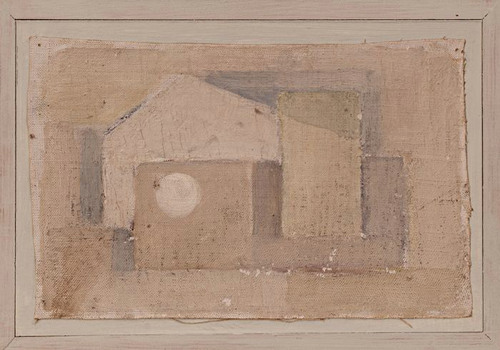Gustav Rudberg (1915-2001)
Målning från medelhavet, 1953
Olja på duk
Förvärvad till Ystads konstmuseums samling 2003

Gustaf Rudberg målade det som fanns nära och vände då särskilt sitt staffli mot det som han uppfattade som vackert och stämningsfullt. Hans samlade produktion omfattar därför många motiv från Ven där han bodde och arbetade om somrarna men också från Ibiza, Mallorca och Madrid där han verkade tätt inpå spanska inbördeskrigets slut. Kompositionen i Målning från medelhavet från 1953 visar konstnärens försök att anpassa sig till en modern tidsanda där naturmåleriet ansågs vara förlegat, borgerligt och utan kritisk potential. Konstdiskursen i Sverige vid den här tiden dominerades av abstraktion och geometri. Det intellektuella samtalet kretsade kring staden och förnuftet, fokus låg på att utmana traditionella konventioner. Rudberg fortsatte trots detta med sitt friluftsmåleri och kom så att vara verksam i en tradition tillhörande den danska konstscenen. Målning från medelhavet bär dock också drag som utmärker konstnärens sätt att arbeta även med hans mer karaktäristiska kust- och landskapsmotiv – formmässig förenkling med ljuset i centrum och med ett lågmält, melankoliskt uttryck.
Gustaf Rudberg föddes 1915 i Stockholm men växte upp på Ven. På 1940-talet studerade han för Kraesten Iversen på Konstakademien i Köpenhamn och senare i Stockholm för Isaac Grünewald. På vinterhalvåret hade Rudberg sin bas i Stockholm där han bearbetade det arbete han utfört under sommaren genom ett kritiskt gallringsarbete. Under sina sista verksamma år förlorade han successivt synen men fortsatte att måla med hjälp av andras beskrivningar av omgivningen. Han assisterades av sin fru Ellen Rudberg. Målningarna från Rudbergs senare produktion präglas av större färgmättnad och starkare kontraster än hans tidigare måleri.
ENGLISH VERSION
Gustav Rudberg (1915–2001)
Painting from the Mediterranean Sea, 1953
Oil on canvas
Acquired for Ystad Art Museum’s collection in 2003
Gustav Rudberg painted what was close at hand and turned his easel in particular toward what he perceived as beautiful and atmospheric. His collected oeuvre therefore includes many scenes from the island of Ven, where he lived and worked during the summers, but also from Ibiza, Mallorca and Madrid, where he worked immediately after the end of the Spanish Civil War. The composition of Painting from the Mediterranean Sea from 1953 shows the artist attempting to adapt himself to the modern age, when nature painting was considered antiquated, bourgeois and devoid of critical potential. The art discourse in Sweden at the time was dominated by abstraction and geometry. The intellectual conversation revolved around the city and reason, and focused on challenging traditional conventions. Nevertheless, Rudberg continued painting outdoors, thus working in a tradition belonging to the Danish art scene. But the Painting from the Mediterranean Sea also bears some distinctive characteristics of the artist’s way of working with his more typical coastal and landscape scenes: formal simplification with light at the centre and a subdued, melancholy expression.
Gustav Rudberg was born in Stockholm in 1915, but he grew up on Ven. In the 1940s he studied under Kraesten Iversen at the Art Academy in Copenhagen and later under Isaac Grünewald in Stockholm. During the colder half of the year, Rudberg was based in Stockholm, where he spent his time critically weeding through and reworking the pieces he had made during the summer. In his final working years, he gradually lost his eyesight but continued to paint with the help of others’ descriptions of his surroundings. He was assisted by his wife, Ellen Rudberg. The paintings from his later career are characterized by more intense colours and stronger contrast than his earlier work.
Text: Ellen Klintenberg
Foto: Benjamin Rembson